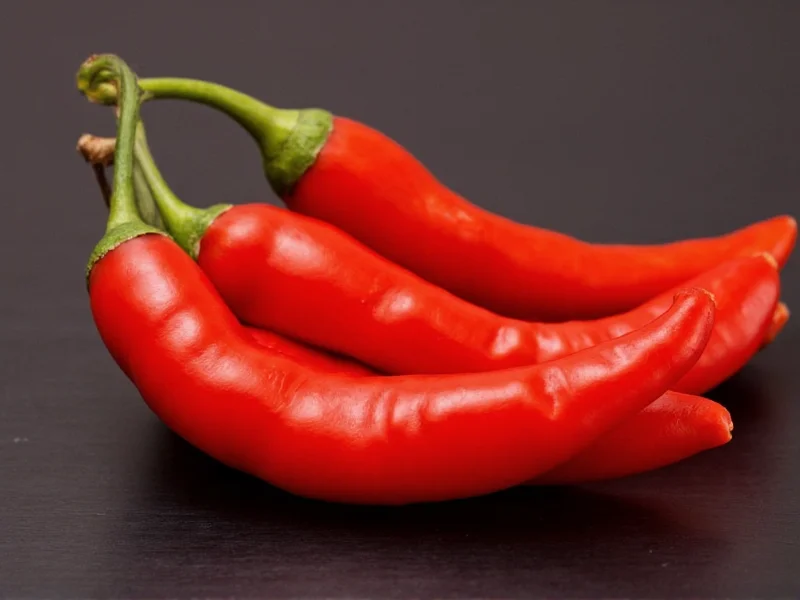If you've ever wondered how hot is a serrano chile compared to other common peppers, understanding its precise heat level can transform your cooking experience. These slender, bright green peppers pack a serious punch that varies based on growing conditions, maturity, and even individual plant genetics.
Understanding the Scoville Scale for Serrano Peppers
The Scoville scale measures chili pepper heat by determining capsaicin concentration—the compound responsible for that burning sensation. When evaluating how hot are serrano peppers compared to jalapenos, the difference becomes immediately apparent:
| Pepper Variety | Scoville Heat Units (SHU) | Heat Relative to Serrano |
|---|---|---|
| Serrano Chile | 10,000-23,000 | Baseline |
| Jalapeño | 2,500-8,000 | 2-5x milder |
| Habanero | 100,000-350,000 | 5-15x hotter |
| Cayenne | 30,000-50,000 | 1.5-2x hotter |
| Thai Bird's Eye | 50,000-100,000 | 3-6x hotter |
Factors That Influence Serrano Pepper Heat Levels
Several elements affect the final heat measurement when determining serrano pepper scoville scale rating:
Color and Maturity
Green serranos (immature) generally register at the lower end of the heat spectrum (10,000-15,000 SHU). As they ripen to red, orange, or yellow, their capsaicin concentration increases, often reaching 20,000+ SHU. Fully mature red serranos deliver the most intense heat experience.
Growing Conditions
Stress factors significantly impact heat production. Serranos grown in:
- Drier conditions develop higher capsaicin levels
- Warmer temperatures increase heat intensity
- Poorer soil quality often produces hotter peppers
- Higher altitude cultivation can boost heat measurement
Individual Variation
Even within the same plant, serrano peppers can show dramatic heat differences. The seeds and white pith contain the highest concentration of capsaicin, so how you prepare the pepper dramatically affects the final dish's heat level.
Practical Implications for Cooking
Understanding are serrano chiles hotter than jalapenos is crucial for recipe success. Serranos deliver a cleaner, brighter heat with less earthiness than jalapeños, making them ideal for:
- Salsas where you want pronounced heat without overwhelming smokiness
- Pickling applications where the thinner walls absorb flavors better
- Traditional Mexican dishes like pico de gallo and chile agua
- Ceviche where the clean heat complements seafood
When substituting serranos for jalapeños, use approximately one serrano for every three jalapeños to maintain similar heat levels. Remember that removing seeds and membranes can reduce heat by up to 80% in your serrano pepper heat level chart calculations.
Safe Handling Practices for Hot Serrano Chilies
Working with serranos requires precautions due to their significant heat level. Follow these safety measures when exploring how to handle hot serrano chilies:
- Always wear gloves when handling or cutting serranos
- Avoid touching your face, especially eyes, during preparation
- Use separate cutting boards for hot peppers
- Wash hands thoroughly with soap and water after handling
- Remove seeds and membranes with precision to control final heat
If you accidentally get serrano oil on your skin, wash with vinegar or milk before soap and water. For eye exposure, flush immediately with cool water for several minutes.
Regional Variations and Cultivars
Different serrano varieties show subtle heat variations. The Tampiqueño 74 cultivar tends toward the milder end (10,000-15,000 SHU), while the larger Hidalgo variety often reaches 20,000+ SHU. Mexican-grown serranos typically exhibit more consistent heat levels than those cultivated in other regions due to generations of selective breeding for culinary applications.
Measuring Heat Accurately at Home
While professional Scoville testing requires laboratory equipment, you can gauge serrano heat through:
- Visual inspection: Smaller, thinner-walled peppers tend to be hotter
- Stem examination: Peppers with pronounced ridges near the stem often pack more heat
- Taste testing (with caution): Start with tiny amounts of the inner membrane
- Comparative tasting: Sample alongside a known-heat pepper like jalapeño
Remember that individual heat tolerance varies significantly, so what seems mild to one person might be extremely hot to another when experiencing serrano chile heat level firsthand.











 浙公网安备
33010002000092号
浙公网安备
33010002000092号 浙B2-20120091-4
浙B2-20120091-4